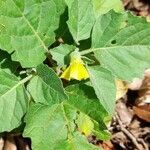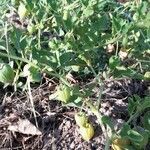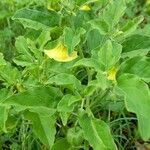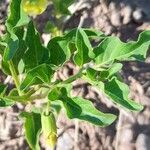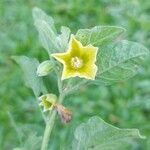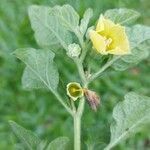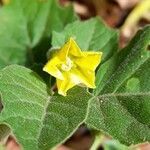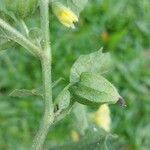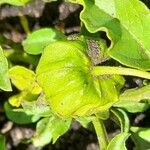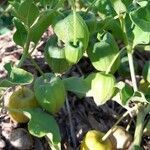Erect to decumbent herb, extensive perennial underground rhizomes. Stems annual, branched. Leaves ovate to elliptical, margins entire or ± dentate, yellow-green, base often unequal, decurrent on ± 10 mm long petiole. Flowers solitary, axillary; pedicels up to 15 mm long. Calyx ± 6 mm long, lobes ± triangular. Corolla campanulate, lobes spreading up to 20 mm in diam., yellow, sometimes with green or ± purple marks in throat. Flowering time Oct.-Mar. Fruit globose berries, 12 mm in diam., yellow, inside inflated membranous calyces up to 25 mm long. Seeds many, lenticular, 1 mm in diam., very finely pitted, yellow-brown.
Leaves solitary or geminate; petiole 0.4–1.8 cm long, slightly winged, rather sheathing at the base; lamina membranous or papyraceous, 0.9–4.2 × 0.4–2 cm, ovate to lanceolate, occasionally elliptic or obovate to spathulate, base cuneate or attenuate (or elsewhere sometimes ± cordate), and often oblique or unequal-sided, ± decurrent into the petiole, apex obtuse or somewhat acute, occasionally bluntly sub-acuminate, entire to coarsely sinuate-dentate distally (very rarely so in the Flora Zambesiaca area), the teeth unequal, obtuse, the sinuses rounded, densely viscid-hairy, glabrescent.
Perennial herb, up to 0.3 m high; covered with stellate and variously branched hairs; sticky. Stems annual from rootstock. Leaves petiolate; blade decurrent, ovate, ± 50 x 30 mm, apex acute, base cuneate, margins distantly scalloped, yellowish green; petioles up to 20 mm long. Flowers: solitary, drooping; anthers yellow, ± 3 mm long; corolla yellowish, usually dark-maculate; Oct.-Mar. Fruit a globose berry, 10-15 mm long, dull yellowish green to orange, completely enclosed by inflated calyx.
An erect plant. It has a spreading habit. The roots are extensive and creeping. It grows 60-180 cm high. It keeps growing from year to year. The leaves are light green and have leaf stalks. The leaves do not have hairs and have a wavy edge. The flowers are yellow. They grow in the axils of the upper leaves. The flowers are bell shaped and 2.5 cm across. They have dark centres. The fruit is a berry which is orange and sticky. It is covered in a thin outer covering.
Erect to decumbent, subdichotomously ± branched, perennial herb, (5)14–40 cm high (said to reach 80 cm elsewhere), arising from an elongated cord-like, flexuous, knotted, creeping rhizome, yellowish-green, viscid, ± clothed all over with stalked-stellate 2–3-branched and also somewhat dendritic, spreading hairs of varying size, short in the Flora Zambesiaca area, more dense on new growth, furnished with sessile glands too.
Corolla yellowish or greenish-yellow, blotched with 5 dark purplish (or green) markings ± contrasting with the surrounding limb, 10–15 mm long, subrotate; tube glabrous, on the inside with dense felted indumentum from near the insertion of the stamens to the mouth; limb 10–15 mm across, sinuate or with 5 ± prominent angles, reflexed when fully expanded, hairy outside, glabrous inside, ciliate.
Stamens slightly exserted, one longer than the other 4, glabrous; filaments 3–5 mm long, filiform, attached to the corolla tube near the base; anthers yellow, 2.5–3 mm long, linear to narrowly ovate-oblong in outline, straight after anthesis.
Erect or decumbent perennial herb, up to 300 mm tall, covered with stellate or variously branched trichomes. Anthers yellow, 3 mm long. Flowers yellowish, usually dark-maculate.
Fruit greenish-yellow to orange, occasionally reddish, subsessile on the invaginated base of the drooping to pendulous calyx, 8 × 7 mm, turbinate or ± globose, viscid.
Flowers solitary, axillary, drooping or nodding; pedicel 10–20 mm long, hairy and glandular, in fruit elongated to 25 mm.
Ovary 1.2–1.7 × 1.2–1.6 mm, ovoid, glabrous; style 7–9 mm long, filiform, straight or slightly bent.
Seeds orange, 2 × 1.8 mm, broadly ovate to suborbicular in outline, reticulate-foveate.
Branches subterete-angular, striate, scabrid.
Disk 0.2–0.3 mm high, fleshy, glabrous.
